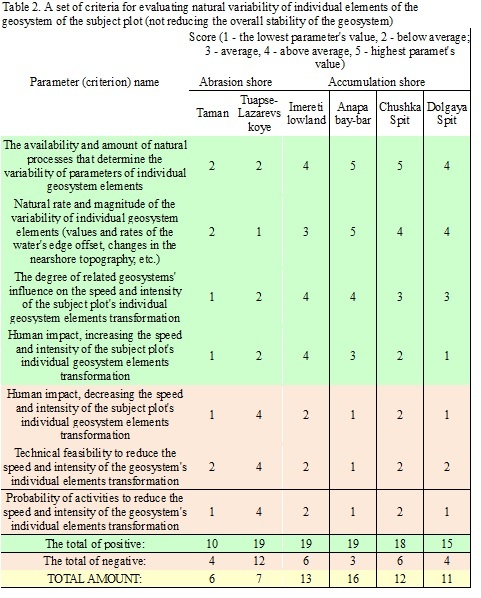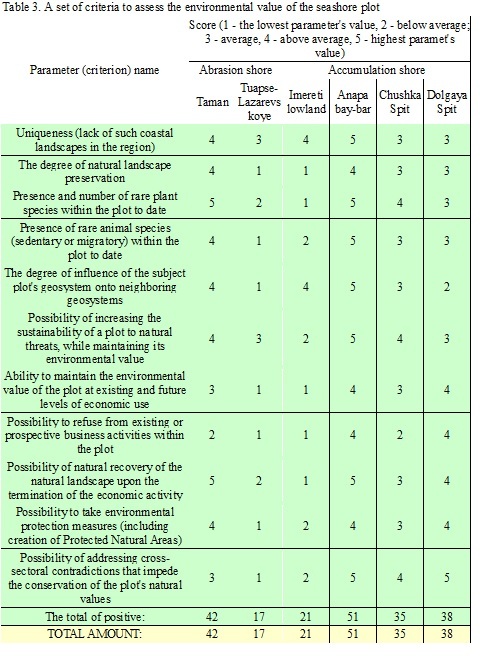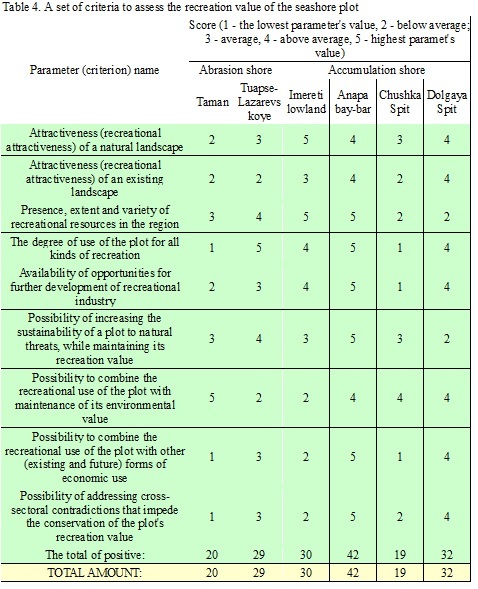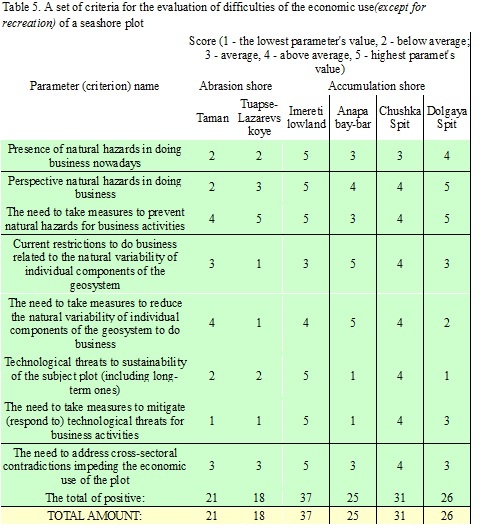Россия
BISAC NAT010000 Ecology
BISAC NAT045050 Ecosystems & Habitats / Coastal Regions & Shorelines
BISAC NAT025000 Ecosystems & Habitats / Oceans & Seas
BISAC NAT045030 Ecosystems & Habitats / Polar Regions
BISAC SCI081000 Earth Sciences / Hydrology
BISAC SCI092000 Global Warming & Climate Change
BISAC SCI020000 Life Sciences / Ecology
BISAC SCI039000 Life Sciences / Marine Biology
BISAC SOC053000 Regional Studies
BISAC TEC060000 Marine & Naval
There are many types of coasts classifications that indicate main coastal features. As a rule, the "static" state of the coasts is considered regardless of their evolutionary features and ways to further transformation. Since the most part of the coastal zone studies aimed at ensuring of economic activity, it is clear that the classification of coast types should indicate total information required by the users. Accordingly, the coast classification should include the criterion, characterizing as dynamic features of the coast and the conditions and opportunities of economic activity. The coast classification, of course, should be based on geomorphological coast typification. Similar typification has been developed by leading scientists from Russia and can be used with minimal modifications. The authors propose to add to basic information (geomorphological type of coast) the evaluative part for each coast sector. It will include the estimation of the coast changes probability and the complexity of the coast stabilization for economic activity. This method will allow to assess the dynamics of specific coastal sections and the processes intensity and, as a result – the stability of the coastal area.
sea coasts, environmental management, typification, criteria, estimation.
Table 4. A set of criteria to assess the recreation value of the seashore plotI. Introduction
Sea coasts have been gaining in economic value year after year. Environmental management structure on the seashores has developed mainly under the influence of physical and geographical conditions, and partially under the influence of the economic-geographical and geopolitical location [1]. In recent decades, these two factors have becoming increasingly important. In fact, this is exactly what fundamentally differs seashores from many other types of landscapes – not only because they have value in themselves (as an economic, recreational, environmental, etc. resource), but also because of their spatial layout. It should be recognized that every stretch of a seashore is unique, with its own set of physical-geographic, socio-economic, environmental and many other characteristics. Building plans for the economic development and protection of the sea coasts is impossible without understanding how environmental conditions and human-induced transformations affect littoral geosystems. For any part of a seashore one needs information about the magnitudes of observed and anticipated changes. The main issues in decision-making are as follows: whether the human-induced change in the seashore can be allowed at all; whether there is a need to protect the coasts from degradation; whether the adaptation of economic activities to possible changes in the seashores is required. Consequently, there is a possibility and a need to make an inventory of all seashores creating a unified Seashore Cadastre. Such a Cadastre could be created based on the Land Cadastre, but must contain much more information, reflecting the high dynamics and complexity of the littoral geosystems - a consequence of the borderline position of coasts at the intersection of different environments. Consequently, it is necessary to develop a system of criteria to be used for classification and assessment of the seashores.
The diversity of natural conditions, under which influence the coast were developing, has resulted in the appearance of many types of seashores, differing in both structure and processes taking place in the littoral zone. In the literature one can find different classifications of shore types, to one extent or another reflecting their diversity [1]. More often these classifications reflect the "static" state of the shores, without taking into account the particularities of their previous evolution and the ways of further transformation. Meanwhile, constant changes, like, the retreat or advancement of shores, change of their types, transformation of lithodynamic systems – all these are absolutely natural processes for coastal ecosystems. The length of the coasts affected in one way or another by man-made transformations increases therewith. Therefore it is required to develop criteria to assess the "dynamics" of different coastal areas, both natural or human-induced.
A large part of the research of the coastal zone of seas is aimed at ensuring economic activity. Nowadays the studies dedicated to the protection of seashores as a unique natural system come to the foreground. Therefore, the criteria used to classify coasts, must first of all characterize the conservation value of seashores and the need to protect them. Thus, the criteria characterizing the conditions and potentials of the economic use of seashores should include the criteria for assessment of natural hazards, environmental restrictions and impact of the previous economic activities.
This paper formulates the basic principles of establishing an integrated system of any Russian seashore area assessment. This assessment should be a basic element in creating the Cadastre of the sea shores of Russia. Given the great length of the Russian seashores, it doesn't seem possible to obtain comprehensive information on each section of the seashore. Therefore, the developed criteria should be evaluative, giving qualitative characteristic to the current state of the shores and processes that determine its preceding and subsequent evolution. Development of the remote-sensing techniques and modern level of theoretical knowledge about the principles of the seashore development allows giving such a qualitative characteristic even for hard-to-reach and understudied littoral areas. In fact, the information provided in the Cadastre of seashores is the initial basis for crucial decision-making [2]. If necessary, more detailed qualitative or quantitative information will be obtained already during the planning of economic or environmental activities.
II. Discussion
The information provided in the Cadastre of seashores shall be sufficient for a qualitative assessment of the immunity of this part of the seashore area to possible reforms, of its economic and environmental values. Thus, it is possible to formulate the basic requirements towards the Russian seashore typification system:
1. Classification should be as simple as possible for the convenience of its use in the decision-making system;
2. Classification should reflect the geological and geomorphological features, characteristics of existing lithodynamic systems specific to the given type of coasts with the assessment of the immunity of these systems to changes in external conditions;
3. Classification should contain information about a sediment budget (sources of materials for building up beaches; availability, intensity and degree of the along-shore sediment flows saturation), as well as trends to change it;
4. Classification shall contain information concerning previous, contemporary and anticipated changes in nearshore underwater and land relief with changing natural and human-induced impacts;
5. Classification should contain information about climatic and hydrological regime and evaluation of current and prospective changes in its settings that might influence the nature and rates of the shoreline development;
6. Classification shall contain an assessment of the conservation values of the coast, including the degree of its influence on adjacent geosystems;
7. Classification shall contain information on the nature and extent of technological transformation of shores and lithodynamic systems (including zones of feeding by sediments);
8. Classification shall contain an assessment of opportunities for the economic use of the coast.
The integrated classification should be based on the geomorphological typification of shores, in which many of the listed criteria are already reflected. Similar typifications have already been developed by leading scientists of Russia [1, 3, 4] and they can be used with minimal modifications.
However the geomorphological information only is not enough to determine the value and vulnerability of a seashore area, or to initiate decision-making. For example if a seashore belongs to the "accumulation" type, it does not necessarily mean a lack of a modern erosion process over there, and vice versa, a complete lack of modern abrasion on a die-out cliff is possible. For each seashore area classification shall contain the evaluation part, which allows you to define a modern and forward-looking dynamics and intensity of any given process. This part of the classification assessment should use digital representation of the different criteria to the full, which will facilitate statistic and evaluation activities and will also allow using this classification as the basis for the development of the Seashore Cadastre. Therefore, the basic qualitative information (geomorphological shore type) must be supplemented by a system of "dynamic" (complementing the "morphological" typification of shores) and "customized" (defining the environmental, recreational and economic value of seashores) criteria.
An approximate example of the "dynamic" and "customized" criteria is given in Tables 1-5. Properties of different geomorphological types of seashore geosystems of the Azov-Black Sea shoreline of Russia were used as an example. Two shore plots of abrasive type are represented: Taman peninsula (made of soft rocks), between the towns of Tuapse and Lazarevskoye (made of solid rocks). Shores of accumulative type are represented by 4 plots: The Imereti lowland (delta foreland, made of cobble and sandy deposits of alluvial origin); the Anapa bay-bar (accumulative form made of sand with transverse movement of sediments); the Chushka spit (accumulative form made of sand mixed with shell with longitudinal movement of sediments); the Dolgaya spit (accumulative form made predominantly of shell with longitudinal movement of sediments). In addition to building up rock and peculiarities of the sediment movement, each of these plots differs in intensity and economic use types. Learn more about these plots in sections [2, 5, 6, 7, 8].
A big problem is the selection of the "positive" or "negative" assessment of one or another criterion. A contradiction between natural laws of development of the coast ("constant transformation") and human needs ("stabilization") is obvious. High natural variability of a particular plot of the sea shore or its gradual retreat far from always points at the destruction of the entire geosystem, that is, it is not a "negative" factor. At the same time high variability of the coast or its retreat almost always prevent or complicate its economic use, thus making it a "negative" factor. In this context, when selecting a criteria we had to clarify what we mean by "seashore sustainability.
From the point of view of natural processes, a steady state of shorelines is in their transformation, reflecting the previous and current natural conditions. So speaking about "natural sustainability of seashore" we mean the continuation of their current development trends and paces. Consequently, for the evaluation of "natural sustainability" information about previous evolution, current status is required, as well a forecast of further transformation of shores and of natural processes determining it. In the light of the foregoing, in our study, we have evaluated separately the exposure of the subject seashore plot to natural hazards (Table 1). In this context, the term "natural hazards" means the processes causing the destruction or irreversible transformation of the entire shoreline geosystem. It is clear that the human impact on littoral processes may both decrease and increase the shoreline geosystem sustainability to the action of natural hazards. To assess this factor, we added in Table 1 the information on existing and prospective human impact on the natural course of the shore development.
From the point of view of human interests, the "human-induced sustainability of the seashores" often means a complete stabilization of the shore in a familiar or comfortable configuration suitable for being engages in a particular activity. Generally, we are talking about consolidation of separate plots of the sea shores (with or without changing their type), with a view to use in future or to protect the already existing facilities. Based on this we have assessed the degree of natural variability of individual geosystem elements of the subject plot (Table 2). This variability has no effect on the overall stability of geosystem, however, it greatly complicates the economic use of the seashores.
Experience shows that the man-induced transformation of coasts (including their stabilization) dramatically changes the established mechanisms for the functioning of the existing lithodynamic systems (for example, by changing the intensity and direction of the flow of substances in the nearshore zone). One and the same activity can therewith have completely different effects. For example, in the abrasion-accumulative pair strengthening of abrasion shores will inevitably lead to the degradation of the accumulative part, while the strengthening of the accumulative part will practically have not affect on the condition of the abrasive plot. Such duality can displayed by natural processes too, for example, the increase in wave action can cause both abrasion acceleration and increase the accumulation rate at which the sediment gets from the bottom or from adjacent shore plots. In order to analyze the feasibility of man-made interference in the course of coastal processes, we assessed the conservation value of the seashore plot (Table 3).
Since natural and/or anthropogenic transformation of the coasts can substantially change their recreational properties, we assessed the recreational value of the seashore plot (Table 4).
.jpg)




III. Conclusions
A preliminary system of criteria used for cadastral typification of the seashores in Russia has been compiled during the study. A comparative assessment was carried out taking test seashore plots as an example.
The preliminary assessment showed that the most dynamic and exposed to natural threats are accumulation shores (Table 1, 2). Whereas the greatest natural threats are the sea level rise and increased wave action. Negative human impact most often shows as the reduction of the volume of sediment being accumulated.
Environmental value of a seashore basically does not depend on its type (Table 3). The most important are the preservation of the natural landscapes and their ability to recover. Another important thing is the possibility of addressing cross-sectoral contradictions impeding the conduct of environmental activities. Unfortunately, much of the coastlines of the Azov-Black Sea coast have already undergone technological transformation, almost losing their environmental value.
Recreational value of the coasts (Table 4) is equally dependent on both physiographic and socio-economic factors. Anapa bay-bar stands out in this respect, where the high variability of the coast and the presence of natural hazards do not reduce the environmental or recreational potential [2, 8].
The difficulties in the seashore development (Table 5) also depend on natural and man-made factors, however, socio-economic situation has a significant impact too. The Imereti lowland stands out notably, where natural hazards were dramatically increased due to irrational human-induced transformation of the lithodynamiс system. That being said, the solution of the problem of protection and further use of the shores is considerably complicated by the hard-to-solve cross-sectoral contradictions.
Therefore, a system of criteria complementing the geomorphological classifications of the seashores was offered as a solution. These criteria enable to do a quality assessment of the dynamics and consumer properties of any plot of various shore types. Following certain modification and tuning these criteria are to be applied when developing the Seashore Cadastre of the Russian Federation.
IV. Acknowledgments
The investigations for this paper were supported by the Russian Science Foundation (project no. 14-50-00095).
1. P.A. Kaplin, O.K. Leontyev, S.A. Lukyanova, L.G. Nikiforov, “Coasts”, Moscow: Mysl, 1991, 479 p. (in Russian).
2. R.D. Kosyan, V.V. Krylenko, “Modern status of marine accumulative shores of Krasnodar region and their use”, Nauchnyi Mir, Moscow, 2014 (in Russian).
3. G.A. Safyanov, “Geomorphology of sea coast”, Моscow, MSU, 1996, 400 p. (in Russian).
4. E.I. Ignatov, “Morphosystemic analysis of coast”, Moscow-Smolensk: Madzhenta, 2006, 348 p. (in Russian).
5. R. Kosyan, S. Kuklev, B. Khanukaev, A. Kochergin, “Problems of the coasts erosion in the North-Eastern Black Sea Region”, J Coast Conserv., 2012, V.16, №3, P. 243-250, (in Russian).
6. R.D. Kosyan, Yu.N. Goryachkin, V.V. Krylenko, V.V. Dolotov, M.V. Krylenko, E.A. Godin, “Crimea and Caucasus accumulative coasts dynamics estimation using satellite pictures”, Turk. J. Fish. Aquat. Sci., 2012, 12, 385-390 p.
7. R.D. Kosyan, M.V. Krylenko, B.B. Chubarenko, D.V. Ryabchuk, “Russian coasts of European seas”, In “Coastal erosion and protection in Europe” (ed. Pranzini E. And Williams A.) UK, “Earthscan”, 2013. 496p.
8. R. D. Kosyan, S. B. Kuklev, and V. V. Krylenko, “Fragile equilibrium of the Anapa Bay Bar”, Priroda, Moscow, 2012, № 2, p. 19-28 (in Russian).
9. R.D. Kosyan, V.N. Velikova, “Coastal zone - Terra (and aqua) incognita”, Integrated Coastal Zone Management in the Black Sea Estuarine, Coastal and Shelf Science, 2016, V. 169, P. A1-A16, Crossref DOI link: http://doi.org/10.1016/j.ecss.2015.11.016







